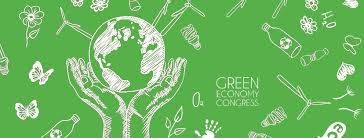Green Economy & Its Importance
Aug 11, 2019 • 261 views

UNEP defines a green economy as one that results in “improved human well-being and social equity, while significantly reducing environmental risks and ecological scarcities”. In its simplest expression, a green economy is low carbon, resource efficient, and socially inclusive. In a green economy, growth in income and employment should be driven by public and private investments that reduce carbon emissions and pollution, enhance energy and resource efficiency, and prevent the loss of biodiversity and ecosystem services.
Since the United Nations Conference on Environment and Development of 1992 (also known as the Rio Conference), the development community has focused its efforts on achieving sustainable development, but the economy in general and businesses in particular have continued to follow a ‘business as usual’ path which has led to increased poverty, degradation of natural resources and ecosystems, loss of biodiversity and ecosystem services, and global warming despite overall growth in gross domestic product (GDP), mainly because of the huge negative externalities that this growth model created. However, the many concurrent crises and market failures of the first decade of the new millennium, particularly the economic recession of 2008?2009 and rising food prices have resulted in widespread disillusionment with the prevailing economic paradigm. On the other hand, increasing evidence points towards an alternative paradigm where increased wealth would not lead to higher environmental risks, ecological degradation, or social disparities.
The green economy approach is an effort to focus sustainable development and poverty reduction efforts on transforming economic activities and economies. Important components of the approach include the use of economic instruments, the creation of an investment-friendly environment, and directing public and private investment towards building natural capital stocks.

Green economy could be an overarching goal for both developed and developing countries in making future development more sustainable. While the concern of the industrialized economies is how to reduce environmental risks and keep the economy green, the concern of the developing economies is how growth can be promoted without degrading the natural resource base and with respect for the principles of low-carbon economy. For the mountain regions, particularly those of the developing economies where millions of people live in a fragile environment and depend mainly on natural resources for their living, the challenge is how to sustainably manage the ecosystems, strengthen resilience to climate change and economic pressures, and promote low-carbon based economic growth and social justice.
The green economy is defined as economy that aims at reducing environmental risks and ecological scarcities, and that aims for sustainable development without degrading the environment. It is closely related with ecological economics, but has a more politically applied focus. The 2011 UNEP Green Economy Report argues "that to be green, an economy must not only be efficient, but also fair. Fairness implies recognizing global and country level equity dimensions, particularly in assuring a just transition to an economy that is low-carbon, resource efficient, and socially inclusive."

A feature distinguishing it from prior economic regimes is the direct valuation of natural capital and ecological services as having economic value (see The Economics of Ecosystems and Biodiversity and Bank of Natural Capital) and a full cost accounting regime in which costs externalized onto society via ecosystems are reliably traced back to, and accounted for as liabilities of, the entity that does the harm or neglects an asset.
Green Sticker and ecolabel practices have emerged as consumer facing measurements of friendliness to the environment and sustainable development. Many industries are starting to adopt these standards as a viable way to promote their greening practices in a globalizing economy.
United Nations Environment launched the Green Economy Initiative (GEI) in 2008, which consisted of global research and country-level assistance encouraging policymakers to support environmental investments within the context of sustainable development. Thanks to this initiative and the work of other agencies, “green economy in the context of sustainable development and poverty eradication” was placed on the 2012 Rio+20 agenda and was acknowledged as a tool for achieving sustainable development.
UN Environment has developed a working definition of a green economy as one that results in improved human well-being and social equity, while significantly reducing environmental risks and ecological scarcities.
Over the past decade, the concept of the Green Economy has emerged as a strategic priority for many governments and intergovernmental organizations. All told, 65 countries have embarked on a path towards an Inclusive Green Economy and related strategies. By transforming their economies into drivers of sustainability, they will be primed to take on the major challenges of the twenty-first century - from urbanization and resource scarcity to climate change and economic volatility.
